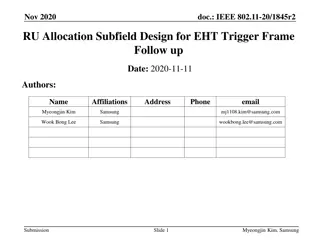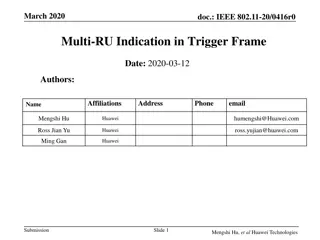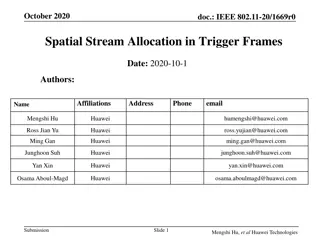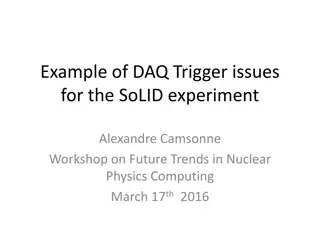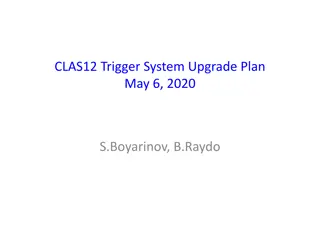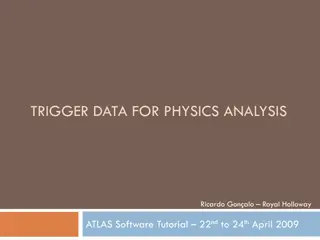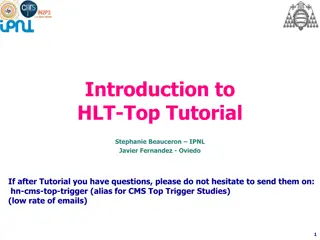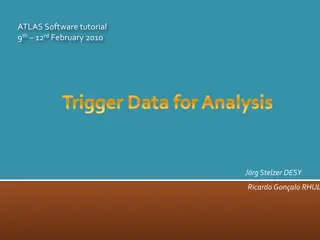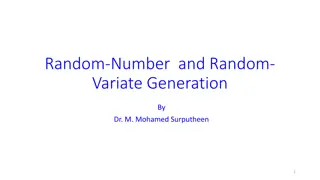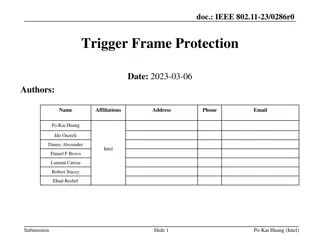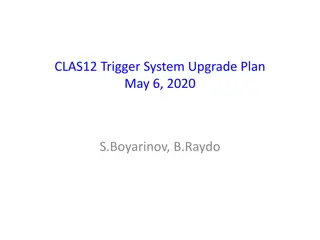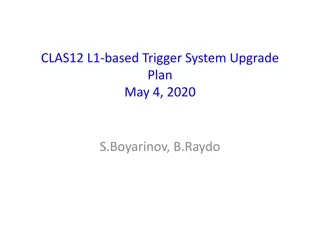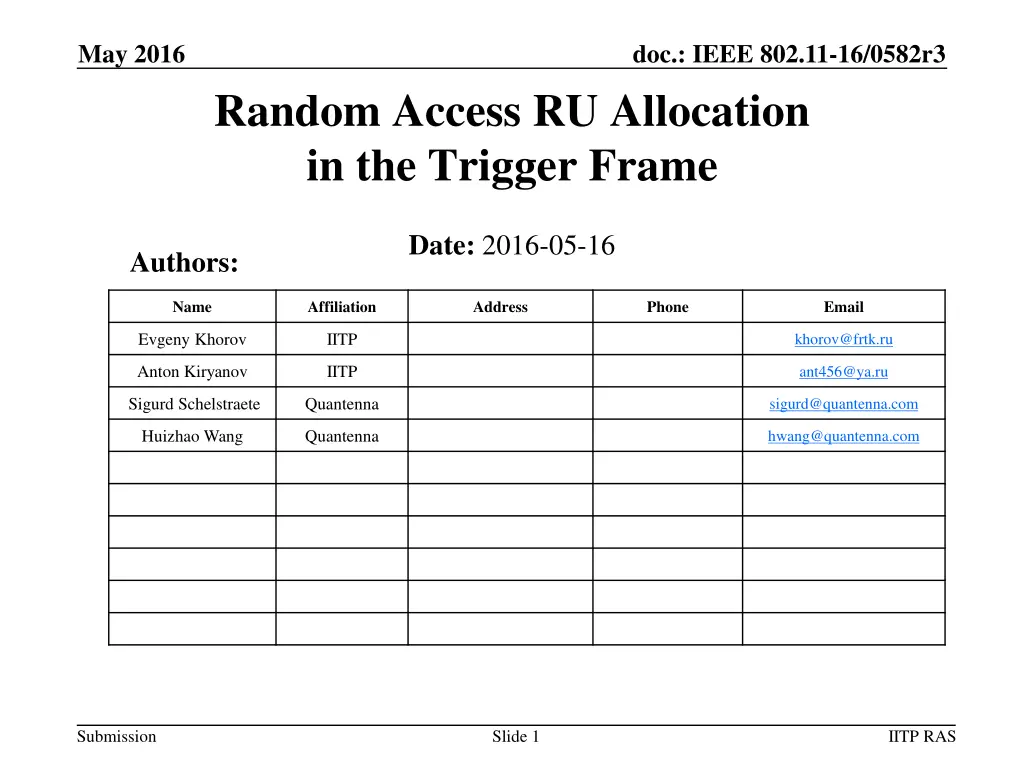
IEEE 802.11-16/0582r3 Random Access RU Allocation
Learn about the allocation of resources for random access in the trigger frame of IEEE 802.11-16/0582r3. The document discusses the signaling and coding for random access RUs, including the User Identifier subfield and RU location details.
Download Presentation

Please find below an Image/Link to download the presentation.
The content on the website is provided AS IS for your information and personal use only. It may not be sold, licensed, or shared on other websites without obtaining consent from the author. If you encounter any issues during the download, it is possible that the publisher has removed the file from their server.
You are allowed to download the files provided on this website for personal or commercial use, subject to the condition that they are used lawfully. All files are the property of their respective owners.
The content on the website is provided AS IS for your information and personal use only. It may not be sold, licensed, or shared on other websites without obtaining consent from the author.
E N D
Presentation Transcript
May 2016 doc.: IEEE 802.11-16/0582r3 Random Access RU Allocation in the Trigger Frame Date: 2016-05-16 Authors: Name Affiliation Address Phone Email Evgeny Khorov IITP khorov@frtk.ru Anton Kiryanov IITP ant456@ya.ru Sigurd Schelstraete Quantenna sigurd@quantenna.com Huizhao Wang Quantenna hwang@quantenna.com Submission Slide 1 IITP RAS
May 2016 doc.: IEEE 802.11-16/0582r3 Background The Trigger frame is used to allocate resource for UL MU transmission and to solicit an UL MU transmission. The Trigger frame also carries other information required by the responding STA to send UL MU. The spec shall define a Trigger frame that allocates resources for random access. [MU Motion 8, July 16, 2015] In [1] the RU allocation signaling for each STA carried in the Per User Info Field of the Trigger frame was proposed. However, current SFD and Draft revisions do not describe how RUs for UL MU random access are signaled. Submission Slide 2 IITP RAS
May 2016 doc.: IEEE 802.11-16/0582r3 Trigger Frame for Random Access or Random Access RUs The Draft describes the following Trigger types Trigger Type value Trigger Type description Basic Trigger Beamforming Report Poll Trigger MU-BAR MU-RTS Reserved 0 1 2 3 4-TBD One way is to have an additional Trigger type, i.e. Trigger Frame Random (TF-R), which allocates resource in UL for random access only. Another way is to allow Basic Trigger also allocating RUs for random access. Submission Slide 3 IITP RAS
May 2016 doc.: IEEE 802.11-16/0582r3 Random Access RUs Currently the User Identifier subfield of the Per User Info field of Trigger Frame indicates the AID of the STA to which an RU described in RU Allocation subfield is allocated. User Identifier RU Coding Type MCS DCM SS Trigger dependent Per User Info Allocation Allocation Figure 9-1 - Per User Info field Following the allocation signaling adopted from [1], it is possible to introduce Random Access User ID (the exact value is TBD) which is placed to User Identifier subfield of the Per User Info field to let an RU be the Random Access RU. Submission Slide 4 IITP RAS
May 2016 doc.: IEEE 802.11-16/0582r3 Recall: RU Allocation info for each STA [1] Proposed to use 8 bits RU allocation signalling to cover all the different BW cases (e.g. 20/40/80/160MHz). The 8 bits RU allocation signalling consists of 1 bit for RU location and 7 bits RU indices. The first bit for RU location indicates the allocated RU is located at the primary or non- primary 80MHz. The subsequent 7 bits indices indicate 69 possible RU allocation cases based on 80MHz tone plan. The mapping of the 7 bits to the RU allocation is defined in the table below. The last entry means RU allocation with the whole 160/80+80MHz. 1 bit for RU location 20MHz 26 7 bits indices Message Number of entries primary 80MHz 0000000 ~ 0100100 Possible 26 RU cases in 80MHz 37* 0 xxxxxxx 52 0100101 ~ 0110100 Possible 52 RU cases in 80MHz 16 106 0110101 ~ 0111100 Possible 106 RU cases in 80MHz 8 0111101 ~ 1000000 Possible 242 RU cases in 80MHz 4 242 1000001 ~ 1000010 Possible 484 RU cases in 80MHz 2 non-primary 1000011 Possible 996 RU cases in 80MHz 1 484 1 xxxxxxx 80MHz 1000100 160MHz/80+80MHz case 1 996 Total 69 160MHz/80+80MHz -> x 1000100 * Note: Signaling for the center 26 unit in 80 MHz is also included. Submission Slide 5 IITP RAS
May 2016 doc.: IEEE 802.11-16/0582r3 Multiple Random Access RUs Allocation To allocate several RUs with the same transmission parameters, we need to repeat Per User Info field many times explicitly. User ID STA1 RU Coding Type MCS DCM SS Trigger dependent Per User Info Trigger dependent Per User Info Trigger dependent Per User Info RU for STA1 Allocation Allocation User ID RA RU Coding Type MCS DCM SS RU for RA (26-tome) Allocation Allocation User ID RA RU Coding Type MCS DCM SS RU for RA (26-tome) Allocation Allocation Redundant information User ID RA RU Coding Type MCS DCM SS Trigger dependent Per User Info Trigger dependent Per User Info Trigger dependent Per User Info Trigger dependent Per User Info RU for RA (26-tome) Allocation Allocation User ID RA RU Coding Type MCS DCM SS RU for RA (26-tome) Allocation Allocation User ID RA RU Coding Type MCS DCM SS RU for RA (26-tome) Allocation Allocation User ID STA2 RU Coding Type MCS DCM SS RU for STA2 Allocation Allocation overhead! Submission Slide 6 IITP RAS
May 2016 doc.: IEEE 802.11-16/0582r3 Overhead estimation In 40 MHz channel @ MCS0 (7.3 Mbps) each Per User Info field (~4 octets) increases TF duration by ~4.4us in average. If #RUs = 18, TF length is 94 octets. If #RUs = 2, TF length is 30 octets. Let TF be followed by BSR(s) of 30 octets. Repetition of Per User Info fields increases TF-BSR cycle from 190 to 260 us (i.e. the overhead is 37%) Submission Slide 7 IITP RAS
May 2016 doc.: IEEE 802.11-16/0582r3 Multiple Random Access RUs If an HE AP wants to allocate multiple RUs for random access with the same parameters (Coding Type, MCS, DCM, SS Allocation), it is better to describe all of them once instead of creating individual entry for each RU. In such a way signaling overhead is reduced. We propose 4 ways how to signal multiple random access RUs and reduce overhead. For that, we extend signaling adopted from [1]. Submission Slide 8 IITP RAS
May 2016 doc.: IEEE 802.11-16/0582r3 1. Interval RUs Allocation for RA To allocate an interval of RUs with the same transmission parameters, we specify only the first and the last RUs of the interval. In TF, the Per User Info field describing the last RU of the interval goes right after Per User Info field describing the first RU of the interval. User ID STA1 RU Coding Type MCS DCM SS Trigger dependent Per User Info Trigger dependent Per User Info RU for STA1 Allocation Allocation User ID RA RU Coding Type MCS DCM SS The first RU of the interval RU for RA (26-tome) Allocation Allocation RU for RA (26-tome) Implicitly defined RUs for RA the same values RU for RA (26-tome) RU for RA (26-tome) User ID RA RU Coding Type MCS DCM SS Trigger dependent Per User Info Trigger dependent Per User Info RU for RA (26-tome) The last RU of the interval Allocation Allocation User ID STA2 RU Coding Type MCS DCM SS RU for STA2 Allocation Allocation Instead of N RUs for RA, advertise only 2 RUs Submission Slide 9 IITP RAS
May 2016 doc.: IEEE 802.11-16/0582r3 1. Example of excluding RUs from RA To allocate just two RUs with the same transmission parameters, we specify them in the descending order (i.e. RU Allocation 1 > RU allocation 2). User ID STA1 RU Coding Type MCS DCM SS Trigger dependent Per User Info Trigger dependent Per User Info RU for STA1 Allocation Allocation User ID RA RU Coding Type MCS DCM SS The first RU RU for RA (26-tome) Allocation 1 Allocation Not assigned space the same values User ID RA RU Coding Type MCS DCM SS Trigger dependent Per User Info Trigger dependent Per User Info RU for RA (26-tome) Allocation 2 RU Allocation Allocation The second RU User ID STA2 Coding Type MCS DCM SS RU for STA2 Allocation Submission Slide 10 IITP RAS
May 2016 doc.: IEEE 802.11-16/0582r3 1. Example of Interval RUs Allocation for RA What happens if the interval of 52-tone RUs includes a 26-tone RU which is not a part of any 52-tone RUs? 26-tone RU is excluded from the interval, but it can be explicitly allocated for deterministic or random access. RU for RA (52-tome) RU for RA (52-tome) User ID RA RU Coding Type MCS DCM SS Trigger dependent Per User Info Allocation Allocation RU for STA1 (26-tome) User ID RA RU Coding Type MCS DCM SS Trigger dependent Per User Info Allocation Allocation RU for RA (52-tome) User ID STA1 RU Coding Type MCS DCM SS Trigger dependent Per User Info Allocation Allocation RU for RA (52-tome) Submission Slide 11 IITP RAS
May 2016 doc.: IEEE 802.11-16/0582r3 2. Explicit Multiple RUs Allocation for RA To allocate multiple RUs with the same transmission parameters, we specify only the first RU and the number of consequent RUs (N). In TF for RA, the Per User Info field contains additional field (N). Trigger dependent Per User Info (0 or no field) RU for STA1 User ID STA1 RU Coding Type SS MCS DCM Allocation Allocation RU for RA (26-tome) The first RU of the interval User ID RA RU Coding Type SS MCS DCM N Allocation Allocation RU for RA (26-tome) RU for RA (26-tome) N RUs for RA RU for RA (26-tome) RU for RA (26-tome) RU for STA2 User ID STA2 RU Coding Type SS MCS DCM 0 or no field Allocation Allocation Instead of N+1 RUs for RA, advertise only 1 RU, however we extend Per User Info field for RA Submission Slide 12 IITP RAS
May 2016 doc.: IEEE 802.11-16/0582r3 3. Implicit Multiple RUs Allocation for RA To allocate multiple RUs with the same transmission parameters, we specify only the first RU. The interval ends when the RU defined in the next Per User Info field starts. Trigger dependent Per User Info Trigger dependent Per User Info User ID STA1 RU for STA1 RU Coding Type SS MCS DCM Allocation Allocation The first RU of the interval User ID RA RU for RA (26-tome) RU Coding Type SS MCS DCM Allocation Allocation RU for RA (26-tome) RU for RA (26-tome) Implicitly defined RUs for RA RU for RA (26-tome) RU for RA (26-tome) The next Per User Info or the end Trigger dependent Per User Info User ID STA2 RU for STA2 RU Coding Type SS MCS DCM Allocation Allocation of TF Instead of N RUs for RA, advertise only 1 RU Submission Slide 13 IITP RAS
May 2016 doc.: IEEE 802.11-16/0582r3 3. Implicit Multiple RUs Allocation for RA Special case: Do not use a part of bandwidth Trigger dependent Per User Info Trigger dependent Per User Info User ID STA1 RU for STA1 RU Coding Type SS MCS DCM Allocation Allocation The first RU of the interval User ID RA RU for RA (26-tome) RU Coding Type SS MCS DCM Allocation Allocation RU for RA (26-tome) RU for RA (26-tome) Implicitly defined RUs for RA RU for RA (26-tome) RU for RA (26-tome) Ends the interval of Trigger dependent Per User Info Empty RU RU Coding Type SS NONE MCS DCM Allocation Allocation RUs We need to define User ID corresponding to No STA Submission Slide 14 IITP RAS
May 2016 doc.: IEEE 802.11-16/0582r3 4. Per 20MHz Random Access RUs Allocation Another approach signalling on per 20 MHz basis Bit B0 indicates whether the described RUs for random access is located at the primary or non-primary 80MHz Bits B1=1, B2=1, B3=1 to distinguish from signalling allocation described in [1] Bits B4 and B5 defines a particular 20 MHz channel within the primary or non-primary 80MHz. Bits B6 and B7 defines how the 20 MHz channel is split into RUs (partition pattern) Primary 80 20MHz B0=0 B6 B7 Partition pattern B4 B5 20 MHz channel First 00 9 x 26-RUs 00 Fist B1 B2 B3 1 1 1 80 MHz 01 4 x 56-RUs Second 01 Second 10 2 x 106-RUs 10 Third Third 11 Reserved (242-RU) non-primary 80 11 Fourth Fourth B0=1 Signaling on per 20 MHz basis can be useful because interference conditions within 20 MHz channel are often similar In addition to 69 combinations used in [1], we propose additional 12 combinations. Thus, 128-69-12=47 combinations are still available for future use. Submission Slide 15 IITP RAS
May 2016 doc.: IEEE 802.11-16/0582r3 Comparison of the Proposed Methods Modification of the Frame Format Flexibility of RU selection Overhead Implementation 1. Interval (First and Last RU) Medium No Good Easy 2. Explicit (First RU, Number of RUs) Small Yes Good Easy 3. Implicit (First RU, the Last RU is defined by the next Per User Info field) Small No Good Medium 4. Per-20MHz Small No Bad Easy Note: Scheme 2 excludes Schemes 1, 3, and 4 Submission Slide 16 IITP RAS
May 2016 doc.: IEEE 802.11-16/0582r3 Summary In this presentation, we propose to allocate RUs for RA in the same way as they are allocated for deterministic access In addition, we propose several ways to allocate multiple RUs for random access with the same parameters (RU size, Coding Type, MCS, DCM, SS Allocation) without creating individual entry for each RU In such a way, signaling overhead is significantly reduced The first 3 approaches slightly modify the existing signaling mechanism Signal the first and the last RUs for RA Signal the first RU for RA and the number N of RUs for RA Signal only the first RU for RA. The Last RU is defined by the next Per User Info field The last approach is an extension of the existing signaling. It is designed for signaling on per 20 MHz basis because interference conditions within 20 MHz channel are often similar In addition to 69 combinations used in [1], we propose to use another 12 combinations. Thus, 47 combinations are still available for future use. Submission Slide 17 IITP RAS
May 2016 doc.: IEEE 802.11-16/0582r3 Straw Poll #1 Do you agree to add the following text in SFD? x.y.z The spec shall define that AID=0 in the User Identifier subfield of the Per User Info field in a Trigger Frame indicates the resource allocation is used for random access by any STA. Y N A Submission Slide 18 IITP RAS
May 2016 doc.: IEEE 802.11-16/0582r3 Straw Poll #2 Do you agree to add the following text in SFD: x.y.z The spec shall provide a way to allocate multiple RUs for random access with the same RU size and other transmission parameters (Coding Type, MCS, DCM, SS Allocation) without creating an individual entry for each RU. Y N A Submission Slide 19 IITP RAS
May 2016 doc.: IEEE 802.11-16/0582r3 Straw Poll #3 Do you agree to add the following text in SFD: x.y.z Multiple RUs for random access with the same RU size and other transmission parameters (Coding Type, MCS, DCM, SS Allocation) can be allocated as follows: A pair of consecutive Per User Info fields with User Identifier = Random Access User ID and with the same RU size and other transmission parameters defines an interval of RUs for RA, if the RU allocation value of the first Per User Info field is smaller than that of the second one. All RUs from the interval have the same size and other transmission parameters. Y N A Submission Slide 20 IITP RAS
May 2016 doc.: IEEE 802.11-16/0582r3 Straw Poll #4 Do you agree to add the following text in SFD: x.y.z Multiple RUs for random access with the same RU size and other transmission parameters (Coding Type, MCS, DCM, SS Allocation) can be allocated as follows If a Per User Info field has User Identifier = Random Access User ID, the Trigger Dependent Per User info contains the number of RUs (N) for random access which follow the defined RU and have the same RU size and other transmission parameters as the defined RU. Y N A Submission Slide 21 IITP RAS
May 2016 doc.: IEEE 802.11-16/0582r3 Straw Poll #5 Do you agree to add the following text in SFD: x.y.z Multiple RUs for random access with the same RU size and other transmission parameters (Coding Type, MCS, DCM, SS Allocation) can be allocated as follows When a Per User Info field has User Identifier = Random Access User ID, the field defines a series of RUs for random access with the same RU size and other transmission parameters. The series includes all RUs up to but not including the RU, defined in the next Per User Info field, if any. Y N A Submission Slide 22 IITP RAS
May 2016 doc.: IEEE 802.11-16/0582r3 Straw Poll #6 Do you agree to add the following to SFD: x.y.z Multiple RUs for random access with the same RU size and other transmission parameters (Coding Type, MCS, DCM, SS Allocation) can be allocated as follows: When a Per User Info field has User Identifier = Random Access User ID, the RU allocation subfield content is as follows. Bit B0 indicates whether the described RUs for random access is located at the primary or non- primary 80MHz Bits B1, B2, B3 are set to 1,1,1. Bits B4-B7 are defined as follows 00 01 B4 B5 20 MHz channel B6 B7 Partition pattern Fist 00 9 x 26-RUs Second 01 4 x 56-RUs 10 Third 10 2 x 106-RUs 11 Fourth 11 Reserved Y N A Submission Slide 23 IITP RAS
May 2016 doc.: IEEE 802.11-16/0582r3 Reference [1] Yunbo Li (Huawei), 0386r0 RU Signaling in Trigger Frame IEEE P802.11-REVmcTM/D4.3 Submission Slide 24 IITP RAS


